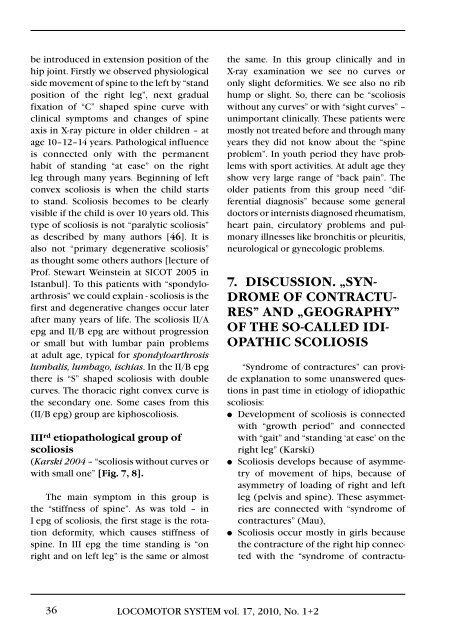1+2/2010 - SpoleÄnost pro pojivové tkánÄ›
1+2/2010 - SpoleÄnost pro pojivové tkánÄ›
1+2/2010 - SpoleÄnost pro pojivové tkánÄ›
Create successful ePaper yourself
Turn your PDF publications into a flip-book with our unique Google optimized e-Paper software.
e introduced in extension position of thehip joint. Firstly we observed physiologicalside movement of spine to the left by “standposition of the right leg”, next gradualfixation of “C” shaped spine curve withclinical symptoms and changes of spineaxis in X-ray picture in older children – atage 10–12–14 years. Pathological influenceis connected only with the permanenthabit of standing “at ease” on the rightleg through many years. Beginning of leftconvex scoliosis is when the child startsto stand. Scoliosis becomes to be clearlyvisible if the child is over 10 years old. Thistype of scoliosis is not “paralytic scoliosis”as described by many authors [46]. It isalso not “primary degenerative scoliosis”as thought some others authors [lecture ofProf. Stewart Weinstein at SICOT 2005 inIstanbul]. To this patients with “spondyloarthrosis”we could explain - scoliosis is thefirst and degenerative changes occur laterafter many years of life. The scoliosis II/Aepg and II/B epg are without <strong>pro</strong>gressionor small but with lumbar pain <strong>pro</strong>blemsat adult age, typical for spondyloarthrosislumbalis, lumbago, ischias. In the II/B epgthere is “S” shaped scoliosis with doublecurves. The thoracic right convex curve isthe secondary one. Some cases from this(II/B epg) group are kiphoscoliosis.III rd etiopathological group ofscoliosis(Karski 2004 – “scoliosis without curves orwith small one” [Fig. 7, 8].The main symptom in this group isthe “stiffness of spine”. As was told – inI epg of scoliosis, the first stage is the rotationdeformity, which causes stiffness ofspine. In III epg the time standing is “onright and on left leg” is the same or almostthe same. In this group clinically and inX-ray examination we see no curves oronly slight deformities. We see also no ribhump or slight. So, there can be “scoliosiswithout any curves” or with “sight curves” –unimportant clinically. These patients weremostly not treated before and through manyyears they did not know about the “spine<strong>pro</strong>blem”. In youth period they have <strong>pro</strong>blemswith sport activities. At adult age theyshow very large range of “back pain”. Theolder patients from this group need “differentialdiagnosis” because some generaldoctors or internists diagnosed rheumatism,heart pain, circulatory <strong>pro</strong>blems and pulmonaryillnesses like bronchitis or pleuritis,neurological or gynecologic <strong>pro</strong>blems.7. Discussion. „Syndromeof contractures”and „geography”of the so-called idiopathicscoliosis“Syndrome of contractures” can <strong>pro</strong>videexplanation to some unanswered questionsin past time in etiology of idiopathicscoliosis:l Development of scoliosis is connectedwith “growth period” and connectedwith “gait” and “standing ‘at ease’ on theright leg” (Karski)l Scoliosis develops because of asymmetryof movement of hips, because ofasymmetry of loading of right and leftleg (pelvis and spine). These asymmetriesare connected with “syndrome ofcontractures” (Mau),l Scoliosis occur mostly in girls becausethe contracture of the right hip connectedwith the “syndrome of contractu-36LOCOMOTOR SYSTEM vol. 17, <strong>2010</strong>, No. <strong>1+2</strong>
















